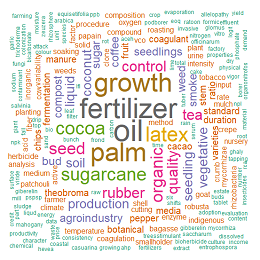Respons Bibit Kelapa Sawit terhadap Berbagai Jenis Bokashi dan Pupuk NPK pada Fase Pre-nursery
DOI:
https://doi.org/10.25181/jaip.v13i1.3869Keywords:
bokashi, NPK fertilizers, oil palm seedling, pre-nurseryAbstract
Improving the quality of PMK soil by applying bokashi and NPK fertilizer is expected to increase the physical and chemical fertility of the soil. This research aims to determine the effect of bokashi and NPK fertilizer and their interaction in improving the growth of oil palm seedlings in PMK soil during the pre-nursery phase. The experiment was conducted in Ensalang Village, Sekadau Hilir District, Sekadau Regency, from October to December 2023. The experiment was arranged using a randomized complete block design (CRD) factorial with two factors. The experiment was repeated 3 times and consisted of 9 samples so that 405 experimental units were obtained. The results showed that the interaction between bokashi and NPK fertilizer affected plant height, dry weight, stem diameter, and root volume. Bokashi independently affects leaf area, plant dry weight, stem diameter, and root volume. NPK fertilizer independently affects plant height, leaf area, and plant dry weight.Downloads
References
Dewi, M., Sarido, L., & Rudi, R. (2023). Pengaruh berbagai macam media tanam terhadap pertumbuhan bibit kakao (Theobroma cacao L.). Jurnal Pertanian Terpadu, 10(2), 153–160. https://doi.org/10.36084/jpt..v10i2.454
Erlida, A., Husna, Y., & Situmorang, Y. (2017). Pengaruh kompos kulit buah kakao dan pupuk fosfor terhadap pertumbuhan dan hasil bawang merah (Allium ascalonicum L.). In G. I. Prayoga, Ropalia, D. Pratama, O. Supratman, & A. F.Syarif (Eds), Prosiding Seminar Nasional BKS PTN Wilayah Barat Bidang Pertanian (pp. 107-112).
Faizal, R., Soedradjad, R., & Soeparjono, S. (2017). Karakter fisiologis dan produksi padi ratun yang di aplikasi Synechococcus sp. dan pupuk organik. Agritrop: Jurnal Ilmu-ilmu Pertanian (Journal of Agricultural Science), 15(2), 162–180.
Ferrarezi, R. S., Lin, X., Gonzalez Neira, A. C., Tabay Zambon, F., Hu, H., Wang, X., Huang, J. H., & Fan, G. (2022). Substrate pH influences the nutrient absorption and rhizosphere microbiome of huanglongbing-affected grapefruit plants. Frontiers in Plant Science, 13(May), 1–17. https://doi.org/10.3389/fpls.2022.856937
Fitriany, E. A., & Abidin, Z. (2020). Pengaruh pupuk bokashi terhadap pertumbuhan mentimun (Cucumis sativus L.) di Desa Sukawening, Kabupaten Bogor, Jawa Barat. Jurnal Pusat Inovasi Masyarakat Juli, 2(5), 881–886.
Hamed, M. H., H, H. M., El-Desoky, M. A., MGhallab, A., & Faragallah, M. A. (2014). effect of incubation periods and some organic materials on phosphorus forms in calcareous soils. International Journal of Technology Enhancements and Emerging Engineering Research, 2(6), 2347-4289
Kalasari, R., Syafrullah, Astuti, D. T., & Herawati, N. (2020). Pengaruh pemberian jenis pupuk terhadap pertumbuhan dan produksi beberapa varietas tanaman semangka (Citrullus vulgaris Schard). Klorofil: Jurnal Penelitian Ilmu-ilmu Pertanian, 15(1), 30–36.
Morgan, J. A. W., Bending, G. D., & White, P. J. (2005). Biological costs and benefits to plant-microbe interactions in the rhizosphere. Journal of Experimental Botany, 56(417), 1729–1739. https://doi.org/10.1093/jxb/eri205
Permatasari, & Nurhidayati, T. (2014). Pengaruh inokulan bakteri penambat nitrogen, pertumbuhan tanaman cabai rawit. Jurnal Sains dan Seni POMITS, 3(2), 44–48.
Rahmawati, I. D., Purwani, K. I., & Muhibuddin, A. (2019). Pengaruh konsentrasi pupuk P terhadap tinggi dan panjang akar Tagetes erecta L. (Marigold) terinfeksi mikoriza yang ditanam secara hidroponik. Jurnal Sains dan Seni ITS, 7(2), 4–8. https://doi.org/10.12962/j23373520.v7i2.37048
Rakesh, J., & Adarsh, V. P. (2010). Effect of vermicompost on growth , yield and quality of tomato (Lycopersicum esculentum L.). African Journal of Basic & Applied Sciences, 2(3), 117–123.
Siregar, L. T., Wardati, & Armaini. (2015). Pemberian limbah cair biogas sebagai pupuk organik pada tanaman kelapa sawit di pembibitan utama. JOM Faperta, 2(1), 10–24.
Siswanto, B. (2019). Sebaran unsur hara N, P, K dan pH dalam tanah. Buana Sains, 18(2), 109-124. https://doi.org/10.33366/bs.v18i2.1184
Suryati, Dhiya, S., Anom, & Edison. (2015). Uji beberapa konsentrasi pupuk cair azolla (Azolla pinnata) pada pertumbuhan bibit kelapa sawit (Elaeis guineensis Jacq.) di pembibitan utama. JOM Faperta, 4(12), 10–14. https://doi.org/10.3969/j.issn.1008-0813.2015.03.002
Suryono, S., & Sudadi, S. (2015). Efek dari kombinasi pupuk N, P dan K terhadap pertumbuhan dan hasil kacang tanah pada lahan kering Alfisol. Agrosains: Jurnal Penelitian Agronomi, 17(2), 49-52. https://doi.org/10.20961/agsjpa.v17i2.18672
Susilo, E., Qalbi, F. H, Tanjung, D. D., Anis, U., Susila, E. N, Pangabean, N. H., ... & Wisnubroto, M. P. (2024). Dasar-dasar Fisiologi Tumbuhan. Hei Publishing.
Downloads
Published
How to Cite
Issue
Section
License
Copyright (c) 2025 Egidius Erido Ridi, Iwan Sasli, Tris Haris Ramadhan

This work is licensed under a Creative Commons Attribution-ShareAlike 4.0 International License.
Authors who publish with Jurnal Agro Industri Perkebunan agree to the following terms:
Authors retain copyright and grant the Jurnal Agro Industri Perkebunan right of first publication with the work simultaneously licensed under a Creative Commons Attribution License (CC BY-SA 4.0) that allows others to share (copy and redistribute the material in any medium or format) and adapt (remix, transform, and build upon the material for any purpose, even commercially) with an acknowledgment of the work's authorship and initial publication in Jurnal Agro Industri Perkebunan.
Authors are able to enter into separate, additional contractual arrangements for the non-exclusive distribution of the journal's published version of the work (e.g., post it to an institutional repository or publish it in a book), with an acknowledgment of its initial publication in Jurnal Agro Industri Perkebunan. Authors are permitted and encouraged to post their work online (e.g., in institutional repositories or on their website) prior to and during the submission process, as it can lead to productive exchanges, as well as earlier and greater citation of published work.


























